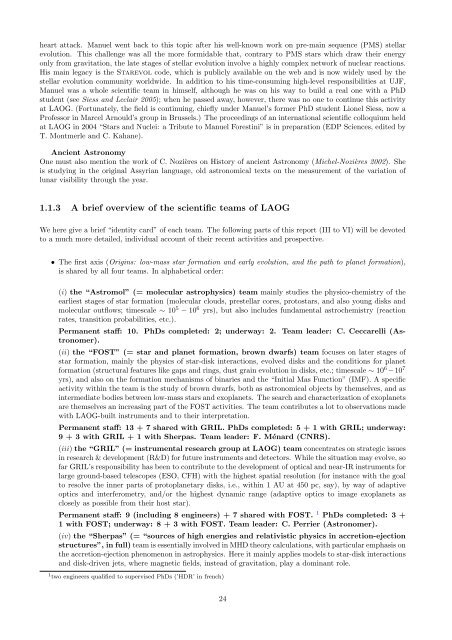Untitled - Laboratoire d'Astrophysique de l'Observatoire de Grenoble
Untitled - Laboratoire d'Astrophysique de l'Observatoire de Grenoble
Untitled - Laboratoire d'Astrophysique de l'Observatoire de Grenoble
You also want an ePaper? Increase the reach of your titles
YUMPU automatically turns print PDFs into web optimized ePapers that Google loves.
heart attack. Manuel went back to this topic after his well-known work on pre-main sequence (PMS) stellar<br />
evolution. This challenge was all the more formidable that, contrary to PMS stars which draw their energy<br />
only from gravitation, the late stages of stellar evolution involve a highly complex network of nuclear reactions.<br />
His main legacy is the Starevol co<strong>de</strong>, which is publicly available on the web and is now wi<strong>de</strong>ly used by the<br />
stellar evolution community worldwi<strong>de</strong>. In addition to his time-consuming high-level responsibilities at UJF,<br />
Manuel was a whole scientific team in himself, although he was on his way to build a real one with a PhD<br />
stu<strong>de</strong>nt (see Siess and Leclair 2005); when he passed away, however, there was no one to continue this activity<br />
at LAOG. (Fortunately, the field is continuing, chiefly un<strong>de</strong>r Manuel’s former PhD stu<strong>de</strong>nt Lionel Siess, now a<br />
Professor in Marcel Arnould’s group in Brussels.) The proceedings of an international scientific colloquium held<br />
at LAOG in 2004 “Stars and Nuclei: a Tribute to Manuel Forestini” is in preparation (EDP Sciences, edited by<br />
T. Montmerle and C. Kahane).<br />
Ancient Astronomy<br />
One must also mention the work of C. Nozières on History of ancient Astronomy (Michel-Nozières 2002). She<br />
is studying in the original Assyrian language, old astronomical texts on the measurement of the variation of<br />
lunar visibility through the year.<br />
1.1.3 A brief overview of the scientific teams of LAOG<br />
We here give a brief “i<strong>de</strong>ntity card” of each team. The following parts of this report (III to VI) will be <strong>de</strong>voted<br />
to a much more <strong>de</strong>tailed, individual account of their recent activities and prospective.<br />
• The first axis (Origins: low-mass star formation and early evolution, and the path to planet formation),<br />
is shared by all four teams. In alphabetical or<strong>de</strong>r:<br />
(i) the “Astromol” (= molecular astrophysics) team mainly studies the physico-chemistry of the<br />
earliest stages of star formation (molecular clouds, prestellar cores, protostars, and also young disks and<br />
molecular outflows; timescale ∼ 10 5 − 10 6 yrs), but also inclu<strong>de</strong>s fundamental astrochemistry (reaction<br />
rates, transition probabilities, etc.).<br />
Permanent staff: 10. PhDs completed: 2; un<strong>de</strong>rway: 2. Team lea<strong>de</strong>r: C. Ceccarelli (Astronomer).<br />
(ii) the “FOST” (= star and planet formation, brown dwarfs) team focuses on later stages of<br />
star formation, mainly the physics of star-disk interactions, evolved disks and the conditions for planet<br />
formation (structural features like gaps and rings, dust grain evolution in disks, etc.; timescale ∼ 10 6 −10 7<br />
yrs), and also on the formation mechanisms of binaries and the “Initial Mas Function” (IMF). A specific<br />
activity within the team is the study of brown dwarfs, both as astronomical objects by themselves, and as<br />
intermediate bodies between low-mass stars and exoplanets. The search and characterization of exoplanets<br />
are themselves an increasing part of the FOST activities. The team contributes a lot to observations ma<strong>de</strong><br />
with LAOG-built instruments and to their interpretation.<br />
Permanent staff: 13 + 7 shared with GRIL. PhDs completed: 5 + 1 with GRIL; un<strong>de</strong>rway:<br />
9 + 3 with GRIL + 1 with Sherpas. Team lea<strong>de</strong>r: F. Ménard (CNRS).<br />
(iii) the “GRIL” (= instrumental research group at LAOG) team concentrates on strategic issues<br />
in research & <strong>de</strong>velopment (R&D) for future instruments and <strong>de</strong>tectors. While the situation may evolve, so<br />
far GRIL’s responsibility has been to contribute to the <strong>de</strong>velopment of optical and near-IR instruments for<br />
large ground-based telescopes (ESO, CFH) with the highest spatial resolution (for instance with the goal<br />
to resolve the inner parts of protoplanetary disks, i.e., within 1 AU at 450 pc, say), by way of adaptive<br />
optics and interferometry, and/or the highest dynamic range (adaptive optics to image exoplanets as<br />
closely as possible from their host star).<br />
Permanent staff: 9 (including 8 engineers) + 7 shared with FOST. 1 PhDs completed: 3 +<br />
1 with FOST; un<strong>de</strong>rway: 8 + 3 with FOST. Team lea<strong>de</strong>r: C. Perrier (Astronomer).<br />
(iv) the “Sherpas” (= “sources of high energies and relativistic physics in accretion-ejection<br />
structures”, in full) team is essentially involved in MHD theory calculations, with particular emphasis on<br />
the accretion-ejection phenomenon in astrophysics. Here it mainly applies mo<strong>de</strong>ls to star-disk interactions<br />
and disk-driven jets, where magnetic fields, instead of gravitation, play a dominant role.<br />
1 two engineers qualified to supervised PhDs (’HDR’ in french)<br />
24




